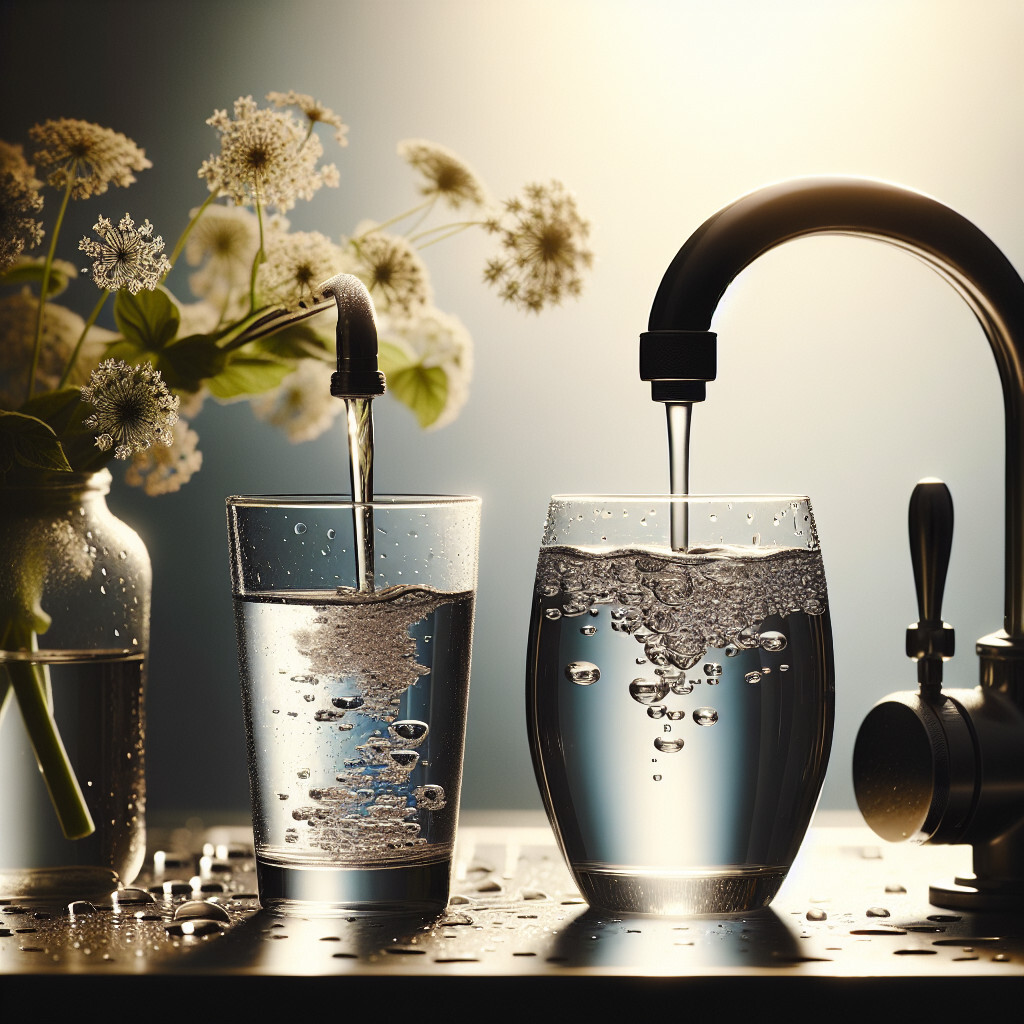-
Table of Contents
“Tap Water vs Sink Water: Same Source, Different Perception.”
Introduction

Tap water and sink water are terms often used interchangeably, but they can sometimes refer to different concepts depending on the context. Tap water generally refers to the water supplied by local municipalities that has been treated and deemed safe for drinking and other uses. It is delivered to households through a complex system of pipes and taps. On the other hand, sink water typically refers to the water that comes specifically from the faucet of a sink. While it is usually the same as tap water, in some cases, it might be further treated or filtered within the household. The comparison between tap water and sink water can involve aspects such as quality, safety, taste, and the presence of additional filtration systems.
Understanding the Differences: Tap Water vs Sink Water
Understanding the differences between tap water and sink water can be a bit confusing, especially since the terms are often used interchangeably. However, there are subtle distinctions that set them apart. This article aims to shed light on these differences, providing a comprehensive understanding of tap water and sink water.
Tap water, as the name suggests, is water that comes directly from the tap. It is supplied by local municipalities and is treated to meet the safety standards set by health authorities. The treatment process typically involves filtration, disinfection, and sometimes, the addition of certain minerals. The goal is to remove harmful substances such as bacteria, viruses, algae, fungi, minerals, and man-made pollutants. The quality of tap water can vary greatly depending on the source and the treatment process. In some regions, tap water is perfectly safe to drink, while in others, it may contain contaminants that pose health risks.
On the other hand, sink water refers to the water that comes out of a specific tap – the one attached to your sink. This water is essentially tap water, but its quality can be influenced by several factors related to the sink and its plumbing system. For instance, the pipes leading to the sink can introduce contaminants into the water. Older pipes may be made of lead or other harmful materials, and if they corrode, these substances can leach into the water. Similarly, the sink itself can be a source of contamination if it is not cleaned regularly.
Furthermore, sink water can also be influenced by any water treatment devices installed at the point of use. These devices, such as water filters or purifiers, can significantly improve the quality of sink water by removing additional contaminants that the municipal treatment process may have missed. However, they can also become a source of contamination if they are not properly maintained. For example, filters can harbor bacteria if they are not replaced regularly.
In essence, while tap water and sink water originate from the same source, the quality of sink water can be influenced by additional factors related to the sink and its plumbing system. Therefore, it is crucial to maintain your plumbing system and any water treatment devices to ensure the safety of your sink water.
In conclusion, the terms tap water and sink water are often used interchangeably, but they can represent different qualities of water. Tap water refers to the water supplied by local municipalities, which is treated to meet safety standards. Sink water, while essentially tap water, can be influenced by the sink, the plumbing system, and any water treatment devices. Understanding these differences can help you make informed decisions about your water consumption and treatment options. Whether you’re drinking tap water or sink water, it’s important to ensure that it’s safe and free from harmful contaminants.
Health Implications: Comparing Tap Water and Sink Water
The health implications of the water we consume daily are a topic of significant concern for many individuals. In this context, the comparison between tap water and sink water becomes a pertinent discussion. While the terms ‘tap water’ and ‘sink water’ are often used interchangeably, there are subtle differences that can have a profound impact on our health.
Tap water, as the name suggests, is water that comes directly from the tap in our homes. It is supplied by local municipalities and is subject to rigorous testing and treatment to ensure it meets the safety standards set by health authorities. This water is treated with various chemicals, including chlorine and fluoride, to kill bacteria and other harmful microorganisms. However, the presence of these chemicals, while necessary for sanitation, has raised concerns about potential health risks. For instance, excessive consumption of fluoride has been linked to dental fluorosis, a condition that causes discoloration and damage to the teeth.
On the other hand, sink water refers to the water that comes out of the faucet in your kitchen or bathroom sink. While this is technically also tap water, it may have been subjected to additional filtration or treatment processes within the home. Many households install water filters or purifiers on their sinks to remove any residual chemicals or contaminants that may be present in the tap water. These filters can significantly improve the taste and odor of the water, making it more palatable for drinking and cooking. Moreover, they can also remove potentially harmful substances like lead, which can leach into the water from old pipes.
However, it’s important to note that not all sink water is filtered. In homes without a filtration system, the sink water is essentially the same as the tap water. Furthermore, even with a filter, the quality of sink water can vary depending on the type and efficiency of the filter used. Some filters may not effectively remove all contaminants, while others may require regular maintenance to ensure their effectiveness.
In terms of health implications, both tap water and sink water have their pros and cons. Tap water is generally safe to drink, provided it comes from a reliable source and meets the necessary safety standards. However, the presence of chemicals and potential contaminants can pose health risks over the long term. Sink water, particularly when filtered, can offer a cleaner and tastier alternative. But the quality of this water largely depends on the effectiveness of the filtration system used.
In conclusion, when comparing tap water and sink water, it’s crucial to consider the source of the water, the treatment processes it has undergone, and any additional filtration systems in place. Both types of water can be safe for consumption, but it’s always advisable to ensure your water source is reliable and meets health standards. If you have concerns about the quality of your tap water, consider investing in a good-quality water filter for your sink. This can provide an added layer of protection against potential contaminants and improve the overall quality of your drinking water.
The Taste Test: Evaluating Tap Water Against Sink Water
The debate between tap water and sink water is a topic that has been discussed extensively in recent years. While some people may use the terms interchangeably, there are subtle differences between the two that can significantly impact their taste and overall quality. This article aims to provide an informative and formal evaluation of tap water against sink water, focusing primarily on the taste test.
Tap water, as the name suggests, is water that comes directly from the tap. It is supplied by local municipalities and is treated to meet the safety standards set by the Environmental Protection Agency (EPA). The treatment process includes filtration, disinfection, and sometimes, the addition of certain minerals to improve the water’s taste and nutritional content. However, the quality and taste of tap water can vary greatly depending on the source and the treatment process. For instance, tap water sourced from a river or a lake may have a different taste compared to that sourced from a well or a spring.
On the other hand, sink water refers to the water that comes out of a specific sink’s faucet. This water is essentially tap water but may have undergone additional filtration or treatment processes. For example, many households and businesses install water filters or purifiers on their sinks to remove any remaining impurities and improve the taste of the water. These additional treatments can significantly alter the taste and quality of sink water, making it different from the original tap water.
The taste of water is influenced by several factors, including its mineral content, the presence of any impurities, and the type of treatments it has undergone. Tap water, due to its treatment at the municipal level, often has a distinct taste. Some people describe it as slightly metallic or chlorinated, which is due to the disinfectants used in the treatment process. Others may find it bland or tasteless, especially if it has been heavily filtered and stripped of its natural minerals.
Sink water, on the other hand, can have a wide range of tastes depending on the type of filter or purifier used. Some filters are designed to remove specific impurities, such as chlorine or lead, which can significantly improve the taste of the water. Others may add minerals back into the water to enhance its flavor and nutritional content. Therefore, sink water can often taste fresher and cleaner than tap water, especially if it has been properly filtered and treated.
However, it’s important to note that the taste of water is highly subjective and can vary greatly from person to person. What one person finds refreshing and delicious, another might find bland or unappealing. Therefore, the best way to determine which type of water you prefer is to conduct your own taste test. Try drinking both tap water and sink water (from a filtered faucet) and see which one you prefer. You might be surprised by the results.
In conclusion, while tap water and sink water may come from the same source, the treatments they undergo can significantly impact their taste and quality. Whether you prefer the taste of tap water or sink water ultimately comes down to personal preference and the specific treatments your water has undergone. By understanding these differences, you can make an informed decision about the type of water that best suits your taste and health needs.
Environmental Impact: Tap Water Versus Sink Water
The environmental impact of our daily water consumption is a topic that has been gaining increasing attention in recent years. As we strive to make more sustainable choices in our everyday lives, it’s important to understand the environmental implications of our water sources. In this context, the comparison between tap water and sink water becomes particularly relevant.
Firstly, it’s crucial to clarify that tap water and sink water are essentially the same thing. Both originate from the same source, be it a municipal water supply, a well, or a spring. The difference lies in the way we perceive and use them. Tap water is often associated with drinking and cooking, while sink water is more commonly linked to cleaning and washing. However, the environmental impact of both can be significant and is largely dependent on the efficiency of our water usage and the quality of our water infrastructure.
The production and distribution of tap water require a considerable amount of energy. Water needs to be collected, treated, and then transported to our homes, often over long distances. This process involves the use of pumps and treatment plants, which are typically powered by fossil fuels. Consequently, the carbon footprint of tap water can be quite high, especially in areas where the water supply is unreliable or the infrastructure is outdated.
On the other hand, sink water, while coming from the same source, can have a different environmental impact due to its usage. When we use water for washing dishes, cleaning, or other household tasks, we often heat it, which requires additional energy. Moreover, the water that goes down the drain carries with it detergents and other pollutants, which can have a detrimental effect on aquatic ecosystems if not properly treated.
However, it’s important to note that the environmental impact of both tap and sink water can be significantly reduced with a few simple measures. For instance, installing energy-efficient appliances and fixtures can lower the amount of water and energy we use. Similarly, being mindful of our water usage, such as not leaving the tap running unnecessarily, can also make a big difference.
Furthermore, improving the quality of our water infrastructure can greatly reduce the environmental impact of our water consumption. This includes upgrading treatment plants to make them more energy-efficient and ensuring that pipes are in good condition to prevent leaks. Additionally, implementing more sustainable water management practices, such as rainwater harvesting and greywater recycling, can also help to lessen our reliance on traditional water sources.
In conclusion, while tap water and sink water come from the same source, their environmental impact can vary depending on how we use them and the efficiency of our water infrastructure. By making conscious choices and advocating for better water management practices, we can significantly reduce the environmental footprint of our water consumption. Therefore, the debate between tap water and sink water is not so much about which is better, but rather about how we can use both in the most sustainable way possible.
Q&A
1. Question: Is there a difference between tap water and sink water?
Answer: No, there is no difference. Tap water and sink water are the same thing. The water that comes out of your sink is referred to as tap water.
2. Question: Is tap water safe to drink?
Answer: Yes, in most developed countries, tap water is safe to drink as it is regulated and tested for safety. However, the quality can vary depending on the location.
3. Question: Can sink water contain contaminants?
Answer: Yes, despite regulations, tap or sink water can still contain small amounts of contaminants such as lead, bacteria, and other substances, depending on the source and treatment of the water.
4. Question: How can I improve the quality of my tap or sink water?
Answer: You can improve the quality of your tap or sink water by using a water filter, which can remove many common contaminants. Regularly cleaning your faucet and using cold water for consumption can also help.
Conclusion
In conclusion, tap water and sink water are essentially the same thing as both come from the same source. The difference may lie in the specific tap or sink it is coming from, which can affect factors such as temperature and potential contamination. However, the water itself is the same.






